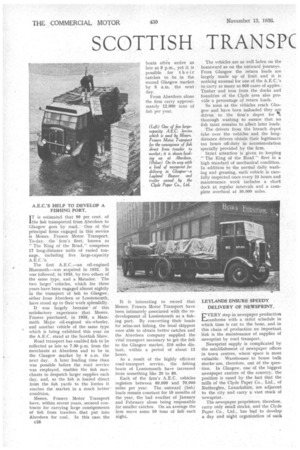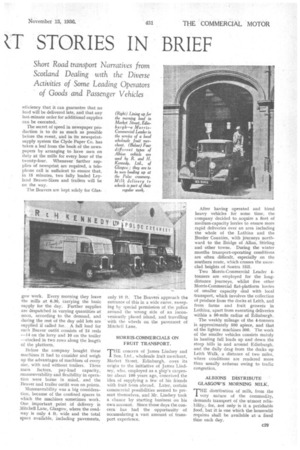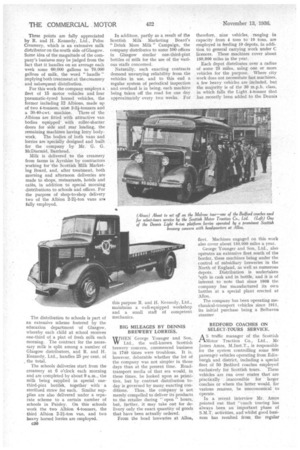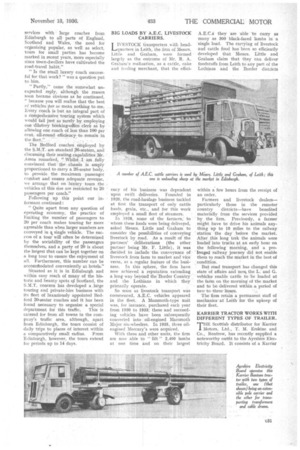SCOTTISH TRANSPC T STORIES IN BRIEF
Page 82

Page 83

Page 84

Page 85

Page 86

If you've noticed an error in this article please click here to report it so we can fix it.
Short Road transport Narratives from Scotland Dealing with the Diverse Activities of Some Leading Operators of Goods and Passenger Vehicles
A.E.C.'S HELP TO DEVELOP A FISHING PORT.
IT is estimated that 90 per cent. of the fish transported from Aberdeen to Glasgow goes by road. One of the principal firms engaged in this service is Messrs. Frasers Motor Transport. To-day, the firm's fleet, known as "The King of the Road," comprises 17 long-distance units of varied tonnage, including five large-capacity A.E.C.'s: The first A.E.C.—an oil-engined Mammoth—was acquired in 1932. It was followed, in 1933, by two others of the same type, and a Matador. The two larger vehicles, which for three years have been engaged almost nightly in the transport of fish to Glasgow, either from Aberdeen or Lossiemouth, have stood up to their work splendidly.
It was largely because of this satisfactory, experience • that Messrs. Frasers purchased, in 1935, a Mammoth Major oil-engined six-wheeler, and another vehicle of the same type which is being exhibited this year on the A.E.C. stand at the Scottish Show.
Road transport has enabled fish to be collected as late as 7.30.p.m. from the merchants at Aberdeen and to be in. the Glasgow market by 6 a.m, the next day. A later loading time than was possible before the road service was employed, enables the fish merchants to despatch larger supplies each day, and, as the fish is loaded direct from the fish yards to the lorries it reaches the market in a much better condition.
Messrs. Frasers Motor Transport have, within recent years, secured contracts for carrying. large consignments of fish from trawlers . that put into Aberdeen for coal. In this case the c28 boats often arrive as late as 9 p.m., yet it is possible for their catches to be in the second Glasgow market by 8 a.m. the next day.
From Aberdeen alone the firm carry approximately 12,000 tons of fish per year.
It is interesting to record that Messrs. Frasers Motor Transport have been intimately associated with the redevelopment Of Lossiemouth as a fishing port. By converting their boats for seine-net fishing, the local skippers were able to obtain better catches and the Aberdeen company supplied the vital transport necessary to get the fish to the Glasgow market, 210 miles distant, within a period of about 12 hours.
As a result of the highly efficient road-transport service, the fishing boats of Lossiemouth have increased from something like 20 to 80.
Each of the firm's A.E.C. vehicles registers between 60,000 and 70,000 miles per year. The. outward (fish) loads remain constant for 10 months.of the year, the bad weather of January and February alone being responsible for smaller catches. On an average the firm move some 50 tons of fish each night. The vehicles are as well laden on the homeward as on the outward journeys. From Glasgow the return loads are largely made up of fruit and it is nothing unusual for one of the A.E.C.'s to carry as many as 600 cases of apples. Timber and iron from the docks and foundries of the Clyde area also provide a percentage of return loads.
So soon as the Vehicles reach Glasgow and have been unloaded they are driven to the firm's depot for II/ thorough washing to ensure that no fish taint remains to affect later loads.
The drivers from the branch depot take over the vehicles and the longdistance drivers obtain their legitimate ten hours off-duty in accommodation specially provided by the firm.
Strict attention is given to keeping " The King of the Road " fleet in a high standard of mechanical condition. In addition to the normal daily washing and greasing, each vehicle is carefully inspected once every 24 hours and maintenance work includes a short dock at regular intervals and a complete overhaul at 30,000 miles.
LEYLANDS ENSURE SPEEDY DELIVERY OF NEWSPRINT.
EVERY step in newspaper production 1---4conforms with a strict schedule in which time is cut to the bone, and in this chain of production an important link is the maintenance of supplies of newsprint by road transport.
Newsprint supply is complicated by the establishment of newspaper offices in town centres, where space is most valuable. Warehouses to house bulk stocks, are, therefore, out of the question. In Glasgow, one of the biggest newspaper centres of the country, the position is eased by the fact that the mills of the Clyde Paper Co., Ltd., of Rutherglen, Lanarkshire, are adjacent to the city and carry a vast stock of newsprint.
The newspaper proprietors, therefore, carry only small stocks, and the Clyde Paper Co., Ltd., has had to develop a day and night organization of such efficiency that it can guarantee that no load will be delivered late, and that any last-minute order for additional supplies cais be executed.
The secret of speed in newspaper production is to do as much as possible before the event, and in its newsprintsupply system the Clyde Paper Co. has taken a leaf from the book of the newspapers by arranging to have men on duty at the mills for every hour of the twenty-four. Whenever further supplies of newsprint are required, a telephone call is sufficient to ensure that, in 15 minutes, two fully loaded Leyland Beaver-Sixes and trailers will be on the way.
The Beavers are kept solely for Glas
gow work. Every morning they leave the mills at 6.30, carrying the basic supply for the day. Further supplies are despatched in varying quantities at noon, according to the demand, and during the rest of the day odd lots are supplied if called for. A full load for each Beaver outfit consists of 24 reels —14 on the lorry and 10 on the trailer —stacked in two rows along the length of the platform.
Before the company bought these machines it had to consider and weigh up the advantages of machines of every size, with and without trailers. Three main factors, pay-loa,d capacity, manreuvrability and flexibility in operation were borne in mind, and the Beaver and trailer outfit wan on points.
Manoeuvrability was a big consideration, because of the confined spaces in which the machines sometimes work. One important point Of delivery is Mitchell Lane, Glasgow, where the roadway is only 4 ft, wide and the total space available, including pavements, only 10 ft, The Beavers approach the entrance of this in a wide curve, sweeping by special permission of the police around the wrong, side of an inconveniently placed island, and travelling with the wheels on the pavement of Mitchell Lane.
MORRIS-COMMERCIALS ON FRUIT TRANSPORT.
THE concern of James Lindsey and Son, Ltd., wholesale fruit merchant, Market Street, Edinburgh, owes its origin to the initiative of James Lindsey, who, employed as a ship's carpenter about 100 years ago, conceived the idea of supplying a few of his friends with fruit from abroad. Later, certain commercial possibilities seemed to present themselves, and Mr. Lindsey took a chance by starting business on his own account. Since those days the concern has had the opportunity of accumulating a vast amount of transport experience.
After having operated and hired heavy vehicles for some time, the company decided to, acquire a fleet of medium-capacity lorries to ensure more rapid deliveries over an area including the whole of the Lothian and the Border Counties, with journeys northward to the Bridge of Allan, Stirling and other towns. During the winter months transport-operating conditions are often difficult, especially on the southern route, which crosses the snow. clad heights of Sontra Hill,
Two Morris-Commercial Leader 9tonners are employed for the longdistance journeys, whilst five other Morris-Commercial flat-platform lorries of smaller capacity deal with local transport, which involves the collection of produce from the docks at Leith, and from farms and fruit growers in Lothian, apart from executing deliveries within a 50-mile radius of Edinburgh.
The weekly mileage of the 4-tonners is approximately 500 apiece, and that of the lighter machines 300. The work of the smaller vehicles consists mainly in hauling full loads up and down the steep hills in and around Edinburgh, and the daily drag from the docks up Leith Walk, a distance of two miles, where conditions are rendered more than usually arduous owing to traffic congestion.
ALBIONS DISTRIBUTE GLASGOW'S MORNING MILK.
THE distribution of milk, from the very nature of the commodity, demands transport of the utmost reliability, for, not only is it a perishable food, but it is one which the housewife requires shall be available at a fixed time each day.
• These points are fully appreciated by R. and H. Kennedy, Ltd., Poloc Creamery, which is an extensive milk distributor on the south side of Glasgow. Some idea of the magnitude of the company's business may be judged from the fact that it handles on an average each week some 60,000 gallons to 70,000 gallons of milk, the word " handle " implying both treatment at the creamery and subsequent distribution.
For this work the company employs a fleet of 15 motor vehicles and four pneumatic-tyred horsed vehicles, the former including 12 Albions, made up of two 4-tonners, nine 2-24-tonners and a 30-40-cwt. machine. Three of the Albions are fitted with attractive van bodies equipped with roller-shutter doors for side and rear loading, the remaining machines having lorry bodywork. The bodies of both vans and lorries are specially designed and built for the company by Mr. G. G. McDiarmid, Barrhead.
Milk is delivered to the creamery from farms in Ayrshire by contractors working for the Scottish Milk Marketing Board, and, after treatment, both morning and afternoon deliveries are made to shops, restaurants, hotels and cafés, in addition to special morning distributions to schools and offices. For the purpose of shop-to-shop delivery two of the Albion 2-21-ton vans are fully employed.
The distribution to schools is part of an extensive scheme fostered by the education department of Glasgow, whereby each child at school receives one-third of a pint of fresh milk each morning. The contract for the necessary milk is split among a number of Glasgow distributors, and R. and H. Kennedy, Ltd., handles 25 per cent. of , the total.
The schools deliveries start from the creamery at 6 o'clock each morning and are completed by about 9 a.m., the milk being supplied in special onethird-pint bottle's, together with a sterilized straw for each. Similar supplies are also delivered under a separate scheme to a certain number of schools in Paisley. On this schools work the two Albion 4-tonners, the third Albion 2-21-ton van, and two heavy horsed lorries are employed.
c.80
In addition, partly as a result of the Scottish Milk Marketing Board's " Drink More Milk" Campaign, the company distributes to some 100 offices in Glasgow similar one-third-pint bottles of milk for the use of the various staffs concerned.
Naturally, such exacting contracts demand unvarying reliability from the vehicles in use, and to this end a regular system of periodical inspection and overhaul is in being, each machine being taken off the road for one day approximately every two weeks. For this purpose R. and H. Kennedy, Ltd., maintains a well-equipped workshop and a small staff of competent mechanics.
BIG MILEAGES BY DENNIS BREWERY LORRIES.
WHEN George Younger and Son, Ltd., the well-known Scottish brewery concern, commenced business in 174-0 times were troublous. It is, however, debatable whether the lot of the company was not simpler in those days than at the present time. Roadtransport media of that era would, in these times, be looked upon as primitive, but by contrast distribution today is governed by many exacting conditions. Thus, the company is not merely compelled to deliver its products to the retailer during " open " hours, but, further, it may take out for delivery only the exact quantity of goods that have been actually ordered.
From the head breweries at Alloa, therefore, nine vehicles, ranging in capacity from 4 tons to 10 tons, are employed in feeding 10 depots, in addition to general carrying work under C licences. These machines cover about 150,000 miles in the year.
Each depot distributes over a radius of some 25 miles, using one or more vehicles for the purpose. Where city work does not necessitate fast machines, a few heavy vehicles are included, but the majority is of the 30 m.p.h. class, in which falls the Light 4-tonner that has recently been added to the Dennis fleet. Machines engaged on this work also cover about 130,000 miles a year.
George Younger and Son, Ltd., also operates an extensive fleet south of the border, these machines being under the control of subsidiary breweries in the North of England, as well as numerous depots. Distribution is undertaken 5qth in cask and in bottle, and it is of interest to note that since 1908 the company has manufactured its own bottles at a special plant erected at The company has been operatingmechanical-transport vehicles since 1911, its initial purchase being a Belhaven steamer BEDFORD COACHES ON SELECT-TOURS SERVICE.
AS traffic manager of the Scottish Motor Traction Co., Ltd., Mr James Amos, M.Inst.T., is responsible for the system controlling some 800 passenger vehicles operating from Edinburgh and district, including a special fleet Of 50 Bedford coaches employed exclusively for Scottish tours. These vehicles are run over routes that are practically inaccessible for larger coaches or where the latter would, for various reasons, be uneconomical to operate.
In a recent interview Mr. • Amps pointed out that "coach touring has always been an important phase of S.M.T. activities, and whilst good business has resulted from the regular services with large coaches from Edinburgh to all parts of England, Scotland and Wales, the need for organizing popular, as well as select, tours for small parties has become marked in recent years, more especially since town-dwellers have cultivated the road-travel habit."
"Is the small luxury coach successful for that work? "was a question put to him.
"Partly," came the somewhat unexpected reply, although the reason soon became obvious as he continued, "because you will realize that the best of vehicles per se mean nothing to .me. Every coach is but an integral part of a Comprehensive touring system which would fail just as surel3r by employing one -dilatory bookingoffice clerk as by allowing one coach of less than 100 Per cent. -all-round efficiency to remain in
the fleet." . .
The Bedford coaches .employed by the S.M.T. are standard 26-seaters, and discussing. their seating capabilities' Mr.
Amos 'remarked Whilst. I am fully convinced that• the chassis is amply proportioned to carry a 26-seater body, to provide the maximum passenger comfort and ensure adequate revenue, we arrange that on luxury tours the vehicles of this size are restricted to 20 passengers per coach."
Following up this point our informant continued:
Quite apart from any question of operating economy, the practice of limiting the number of passengers to 20 per coach makes touring far more agreeable than when larger numbers are conveyed in q. single vehicle. The success of a tour will often be determined by the sociability of the passengers themselves, and a party of 20 is about the largest that can be kept together on a long tour to ensure the enjoyment of all. Furthermore, this number can be accomModated conveniently at hotels." Situated as it is in Edinburgh and within easy reach of many of the historic and beauty spots qf Scotland, the concern has developed a _large touring and private-hire business with its fleet of luxuriously appointed Bedford 20-seater coaches and it has been found necessary to organize a special
department for this traffic. This is catered for from all towns in the company's traffic area, although,, apart from Edinburgh, the tours consist of daily trips to places of interest within a comparatively small radius. From Edinburgh, however, the tours extend for periods up to 14 days. BIG LOADS BY A.E.C. LIVESTOCK CARRIERS.
LIVESTOCK transporters with headLaquarters in Leith, the firm of Messrs. Little and Graham, were formed largely as the outcome of Mr. R. A. Graham's realization, as a cattle, cake and feeding merchant, that the effici
ency of his business was dependent upon swift deliveries. Founded in 1420, the road-haulage business tackled at first the transport of only cattle foods, grain, etc., and for this work employed a small fleet of steamers.
In 1928, some of the farmers; to whom these foods were being delivered, asked Messrs. Little and Graham to consider the possibilities of conveying livestock by road. As a result of the partners' deliberations (the -other partner being Mr. F. Little), it was decided to include the conveyance oflivestock from farm to market and Vice versa, as a regular feature of the buSi. ness. In this sphere, the firm have now achieved a reputation extending a long way beyond the Border Country and the Lothians in which they primarily operate.
So soon as livestock transport was commenced, A.E.C. vehicles appeared in the fleet. A Mammoth-type unit was, for instance, purchased each year from 1930 to 1933: these and succeeding vehicles have been subsequently converted into ! oil-engined Mammoth Major six-wheelers. In 1935, three oiIengined Mercury's were acquired.
With these and other units, the firm are now able to " lift " 2,400 lambs at one time and on their largest A.E.C.s they are able to carry as many as 300 black-faced lambs in a single load. The carrying of livestock and cattle food has been so efficiently developed that Messrs. Little and Graham claim that they can deliver foodstuffs from Leith to any part of the Lothians and the Border districts within a few hours from the receipt of an order.
Farmers and livestock dealers— particularly those in the remoter country districts--have benefited materially from the services provided by the firm. Previously, a farmer might have to drive his animals anything up to 10 miles to the railway station the day .before the market. After this long trek the animals were loaded into traits at an early hour on the following morning, and a prolonged railway journey did not enable them to reach the market in the best of condition.
But road transport has changed this state of affairs and now, the L. and G. vehicles enable cattle to be loaded at the farm on the morning of the market and to be delivered within a period of two tothreehours.
The firm retain a permanent stall of mechanics at Leith for the upkeep of their fleet.
KARRIER TRACTOR WORKS WITH DIFFERENT TYPES OF TRAILER.
THE Scottish distributor for Karrier Motors, Ltd., T. M. Erskine and Co., Renfrew, has recently supplied a noteworthy outfit to the Ayrshire Electricity Board. It consists of a Karrier
Bantam tractor, together with a dropframe trailer designed to carry transformers and cable-drums, and a second trailer for pole carrying. The two trailers are of the quickly detachable type, incorporating Karrier BK-pattern automatic coupling gears, and they are four-point supported when uncoupled.
As a strong -and light four-wheeled tractor was necessary, a Karrier Bantam was selected, and this, with its good manceuvrability, has proved admirably suited to the work. It incorporates a four-cylindered engine developing 47 b.h.p., and is capable of tackling loads in the region of 5 tons.
With regard to the trailers, that designed for carrying cable drums has a low-level body space of approximately 10 ft. by 6 It. 6 ins., and a loading height °I 2 ft. On the high-level space above the turntable is mounted the hand-operated winch and a toolbox. The near side of the trailer has a drop side for about 6 ft. of its length, the other side being rigid. The tailboard is, of course, hinged, and when in the " down" position forms a ramp up which cable drums are hauled. It is interesting to note that when, operating with the cable-drum trailer the outfit can turn easily in a 25-ft. wide street without the necessity of reversing.
The second trailer, which is designed for carrying poles up to 30 ft. long used fo., supporting overhead wires in outlying districts, is of all-steel construction and is mounted on 32-in. by 6-in, twin tyres. Different lengths can be accommodated, as the rear bolster can be located in various positions along the centre pole. To compensate for this variation in length, a drumand-ratchet device is incorporated in the brake-cable layout.








































































































































































